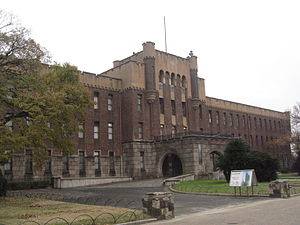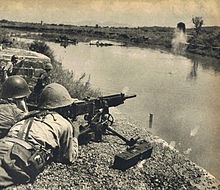4th Division (Japanese Empire)
|
4th division |
|
|---|---|
 Osaka Castle , Osaka, Kansai Region, the former headquarters of the 4th Division. |
|
| active | May 14, 1888 to 1945 |
| Country |
|
| Armed forces |
|
| Armed forces |
|
| Branch of service | infantry |
| Type | division |
| Strength | 15,000-20,000 |
| Location | Osaka , Kansai region |
| Nickname | Yodo-heidan ( 淀 兵 団 , "Yodo Division") |
| Butcher |
First Sino-Japanese War
Siberian Intervention |
The 4th Division ( Japanese 第 4 師 団 , Dai-yon shidan ) was a division of the Imperial Japanese Army , which existed from 1888 to 1945 . Your Tsūshōgō code (military code name) was Yodo Division ( 淀 兵 団 , Yodo-heidan ), so called because of the Yodo River , or 4050 .
General data
The origins of the 4th Division go back to the troops stationed in the Osaka garrison. On the recommendation of the Prussian military advisor Jakob Meckel , the first six divisions were formed from the six regional commands that had existed since 1871. The division was activated on May 14, 1888 in Osaka, in the Kansai region , and comprised approximately 10,000 men. In the course of its operational history, it fought against opponents of the Japanese Empire such as the Qing Dynasty , the Republic of China , Russia , the United Kingdom and the USA . Its last location was in Lampang , Thailand , where it was disbanded in 1945.
History of unity

In May 1888 it was formed as a square division from the 7th Brigade (8th and 70th Infantry Regiment) and 32nd Brigade (37th and 61st Infantry Regiment), the 4th Cavalry Regiment and the 4th Artillery -Regiment set up.
In 1895 she took part in the First Sino-Japanese War.
During the Russo-Japanese War 1904–1905, she was initially under the 2nd Army under the command of Lieutenant General Ogawa Mataji and landed in May 1904 at Pitzuwo, about 80 km northeast of Port Arthur. Shortly thereafter, she took part in the Battle of Nanshan . This was followed by the battles of Te-li-ssu , Tashihchiao and Liaoyang . In September 1904, Lieutenant General Tsukamoto Katsuyoshi took over the division, which was subsequently subordinated to the 4th Army , with which it took part in the Battle of Shaho and the Battle of Mukden .
From 1918 to 1922 the 4th Division was involved in the Siberian Intervention . She was part of the Entente Powers that supported the White Army in the Russian Civil War against the Bolshevik Red Army . In the course of the operation, all ports and major cities in the Russian province of Primorye and eastern Siberia were occupied. Given the withdrawal of their allies and the high costs, the Japanese soldiers also withdrew in October 1922.
From 1937 the 4th Division took part in the Second Sino-Japanese War . In August 1940 the division was converted into a triangular division with three regiments.
At the end of the Pacific War , its last location was Lampang , Thailand , where it was dissolved in 1945.
structure
1888
- 7th Brigade
- 8th Infantry Regiment
- 37th Infantry Regiment
- 19th Brigade
- 9th Infantry Regiment
- 38th Infantry Regiment
- 4th Cavalry Regiment
- 4th Artillery Regiment
- 4th Engineer Regiment
1905
- 7th Brigade
- 8th Infantry Regiment
- 70th Infantry Regiment
- 32nd Brigade
- 37th Infantry Regiment
- 61st Infantry Regiment
- 4th Cavalry Regiment
- 4th Artillery Regiment
- 4th Engineer Regiment
- 4th Transport Regiment
At the end of the war in 1945
- 8th Infantry Regiment
- 37th Infantry Regiment
- 61st Infantry Regiment
- 4th Field Artillery Regiment
- 4th Military Police Regiment
- 4th Engineer Regiment
- 4th Transport Regiment
guide
Division commanders
- Takashima Tomonosuke, Lieutenant General: May 14, 1888 - May 17, 1891
- Kurokawa Tsu, Lieutenant General: June 1, 1891 - November 10, 1893
- Prince Kitashirakawa Yoshihisa , Lieutenant General: November 10, 1893 - January 28, 1895
- Yamazawa Shizuware, Lieutenant General: January 28, 1895 - March 30, 1897
- Ogawa Mataji, Lieutenant General: April 8, 1897 - September 3, 1904
- Tsukamoto KatsuYoshimi, Lieutenant General: September 3, 1904 - July 6, 1906
- Inoue Raito, Lieutenant General: July 6, 1906 - December 17, 1908
- Tsuchiya Mitsuharu, Lieutenant General: December 21, 1908 - August 26, 1910
- Asada Shun Hing, Lieutenant General: August 26, 1910 - September 6, 1911
- Ichinohe Hyoe, Lieutenant General: September 6, 1911 - December 26, 1912
- Osako Naomichi, Lieutenant General: December 26, 1912 - February 15, 1915
- Hitoshi Tahara Shigeyuki, Lieutenant General: February 15, 1915 - August 18, 1916
- Utsunomiya Taro, Lieutenant General: August 18, 1916 - July 24, 1918
- Tachibana Koichiro, Lieutenant General: July 24, 1918 - April 12, 1919
- Machida Kei, Lieutenant General: April 12, 1919 - June 15, 1921
- Suzuki Shoroku, Lieutenant General: June 15, 1921 - August 6, 1923
- Muraoka Chotaro, Lieutenant General: August 6, 1923 - August 10, 1927
- Takashi Hishikari Lieutenant General: August 10, 1927 - August 10, 1928
- Hayashi Wataru Miyoshi, Lieutenant General: August 10, 1928 - December 22, 1930
- Nobuyuki Abe, Lieutenant General: December 22, 1930 - January 9, 1932
- Terauchi Hisaichi, Lieutenant General: January 9, 1932 - August 1, 1934
- Prince Higashikuni Naruhiko, Lieutenant General: August 1, 1934 - December 2, 1935
- Yoshitsugu Tatekawa, Lieutenant General: December 2, 1935 - August 1, 1936
- Imai Kiyoshi, Lieutenant General: August 1, 1936 - March 1, 1937
- Matsu Iinochi, Lieutenant General: March 1, 1937 - July 15, 1938
- Sawada Shigeru, Lieutenant General: July 15, 1938 - September 23, 1939
- Tomoyuki Yamashita Lieutenant General: September 23, 1939 - July 22, 1940
- Kitano Kenzo, Lieutenant General: July 22, 1940 - July 18, 1942
- Sekihara Genroku, Lieutenant General: July 18, 1942 - September 25, 1943
- Baba Masao, Lieutenant General: September 25, 1943 - December 26, 1944
- Kimura Matsujiro, Lieutenant General: December 26, 1944 - August 1945
See also
literature
- US General Staff: Epitome of the Russo-Japanese War . US War Department, 1907.
- Rotem Kowner : The A to Z of the Russo-Japanese War. Scarecrow Press, Lanham 2009, ISBN 978-0-8108-6841-0 .
- Committee of Imperial Defense (UK). Official History of The Russo-Japanese War. 1908
- Victor Madej: Japanese Armed Forces Order of Battle 1937–1945. Volume I + II, Game Marketing Company, 1981
Web links
- 師 団 Ⅰ. Organization of IJA, accessed January 2, 2015 . , Japanese